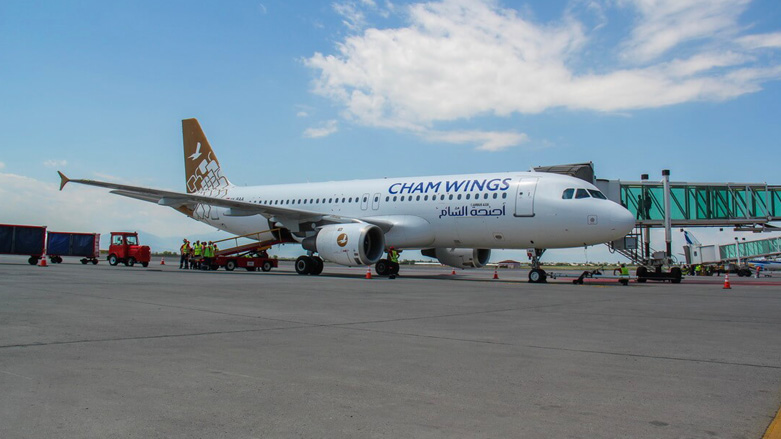Hybrid Warfare: Russia uses sanctioned airline to send mercenaries to Syria

WASHINGTON DC, United States (Kurdistan 24) – Moscow has been using an airline company which is under US sanctions to fly Russian mercenaries to and from Syria.
The US Treasury Department sanctioned the Syrian company, Cham Wings, in 2016, saying it was controlled by the Syrian government and used by the Quds Force of Iran’s Islamic Revolutionary Guards Corps (IRGC).
Following an extensive investigation, Reuters reported on Friday that Cham Wings was being used to fly Russian military contractors to and from Syria.
Cham Wings uses an airport in southern Russia, not far from Ukraine, for the Syrian flights. The planes arrive and depart late at night and do not appear on any airport or airline schedules.
Moscow is using military contractors in Syria, Reuters suggested, to minimize casualties among its own troops.
“The issue of military casualties is highly sensitive in Russia,” the news agency explained, “where memories linger of operations in Chechnya and Afghanistan that dragged on for years.”
Using contractors also provides deniability to the Russian government.
In early February, a large force, including Russian T-55 and T-72 tanks, gathered to attack Deir al-Zor, a Syrian city in the middle Euphrates River Valley, held by the Kurdish-led Syrian Democratic Forces (SDF), America’s main ally in the fight against the Islamic State (IS) in Syria. US forces were also present in Deir al-Zor, although the attackers may not have known that.
The US watched the opposing force gather, puzzled as to just what it was. The Americans maintain a “deconfliction hotline” with their Russian counterparts in Syria and asked them about the mysterious force.
The Russians replied that they had no knowledge of it. When the force began to attack SDF headquarters on the night of Feb. 7, the US launched a crushing counter-assault, using AC-130 ground-attack planes and armed drones.
Some 100 men in the attacking force died—with just one casualty, a wounded SDF fighter, on the coalition side.
It soon emerged that many of the casualties were Russian—military contractors, hired by the Wagner Group, a Russian company owned by Yevgeny Prigozhin, an oligarch with close ties to Russian President Vladimir Putin.
It appears that some authority—Syrian or Russian—thought Turkey’s assault on Afrin may have pulled away enough Kurdish fighters, that it might be possible to seize Deir al-Zor.
This incident illustrates how military contractors are used for risky actions to minimize losses among regular Russian forces.
Indeed, the widow of one contractor killed in Syria told Reuters that her husband had said that Russian contractors were “often sent into the thick of the battle” and were “the first to enter captured towns.”
The Wagner Group was also involved in Russia’s occupation of the Crimean Peninsula in 2014 and then became involved in supporting pro-Russian rebels in Eastern Ukraine.
But its activities are not limited to paramilitary operations. US Special Counsel Robert Mueller, who is investigating Russian interference in the 2016 Presidential elections and possible ties between Russia and the Trump campaign, indicted Prigozhin in February.
Prigozhin ran a St. Petersburg company, the Internet Research Agency, which functioned as a “troll farm” that sought to manipulate US public opinion through false postings to social media.
The activities of figures like Prigozhin provide deniability to the Russian government. It certainly looks like the Wagner Group was acting at official behest, but the situation lacks the clarity that would follow the discovery that an official Russian agency was involved in such actions.
Americans have come to call such activities “hybrid warfare.” However, the very terminology betrays a bias. Warfare is properly what US military forces—Army, Navy, Air Force, and Marines—do.
Conflict outside of that gets a different name: hybrid warfare, or asymmetric warfare. Disciples of the late John Boyd, a brilliant Air Force pilot and military strategist, were the first to flesh out this idea and called it “Fourth Generation Warfare.”
The underlying notion is simple: the US became so dominant in conventional forms of warfare, that its enemies will adopt other ways to fight. But to recognize that and counter it can be difficult.
Iran presents a good example. Tehran extends its influence over other countries not so much by conventional armed conflict, but by undermining and subverting a state from within, through its intimate understanding of local society and the skillful cultivation and use of proxies.
Iran has done that in Lebanon, and, quite arguably, it is doing that now in Iraq—right under the nose of Americans!
Editing by Karzan Sulaivany
